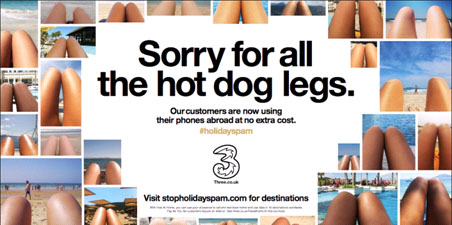Use a “soft launch” for a new strategy. Aim to get a real, human insight to inform the creative. And deploy cutting-edge tech to get your message out there. Those are the big learnings from the best-performing UK campaigns of the year.
Warc invited the teams behind ‘Holiday Spam’ (for Three, the telecoms brand), ‘This Girl Can’ (for government body Sport England) and ‘Raising Eyebrows and Subscriptions’ (for The Economist, the current affairs magazine) to discuss their work at an event in London this week. We think these campaigns are Britain's best, as they were ranked top in the UK on this year’s Warc 100: our annual rankings of the world’s best marketing campaigns and companies, according to performance in effectiveness and strategy competitions.
To Nick Exford, a planner at Wieden + Kennedy, the agency behind ‘Holiday Spam’ – which was ranked number one UK campaign, and number 13 worldwide on the Warc 100 – a “soft launch” period to try out the client’s product innovation was key to building the strategy. Three allowed customers to use their phones abroad at no extra cost. But, even with this great offer, said Exford, the super-competitive mobile market meant the company “was struggling to get customers in the front door – and to stop them sneaking out the back door”.
For the soft launch of the roaming deal, it tracked a group of customers’ mobile data usage while abroad. It found that they used 71 times the data they would have used if they were being charged as normal. More interestingly still, much of this extra usage wasn’t going on responsible services such as maps and local restaurants – it was going on people posting pictures on social media. This, naturally, led to basing the campaign creative around the phenomenon of people posting clichéd pictures of plane wings and cocktails while on holiday. In ads, Three apologised on behalf of its customers for causing a '#HolidaySpam crisis'. When the agency first presented this idea to the client, the marketing manager said: “You want us to apologise for the best thing we’ve ever done? I love it!”

She was right to love it. The campaign led to a 90% increase in Three’s social conversation volume, higher brand metrics and customers saving a collective £2.7bn on roaming charges. “One of the big things we learned was to soft test the offer among our existing customers first,” Exford said. “It really led us to the insight, which led us to the big idea.”
A very different UK campaign came second on this year’s Warc 100. FCB Inferno’s ‘This Girl Can’ campaign for Sport England, which came 20th on the global rankings, also used a soft launch in the initial testing period – but went on to launch creative that was uplifting and sincere, rather than a tongue-in-cheek apology. Nicola Willison, senior strategist at FCB, explained that the simple human insight behind ‘This Girl Can’ – women often feel inhibited about exercising, due to social pressures and prejudices – fed into a complex multi-stage media strategy.
A “soft launch” period, where online video was seeded via PR partners, led to a big above-the-line push with a TV ad and billboards. This in turn led to a big social media reaction – with the positive message resonating deeply with the female target audience. “I’ve never been involved in a campaign where people are tweeting pictures of the billboards,” Willison said. “And I’ve definitely never been involved in a campaign where someone’s got a tattoo of it.” (Though FCB’s art director noticed that the THIS GIRL CAN tattoo in question didn’t use the correct font.)

‘Holiday Spam’ and ‘This Girl Can’ both turned a massive social media response into big business results. Along with 57m views of the main campaign ad online, and 800,000 shares, 2.6m women have taken more exercise as a result of ‘This Girl Can’.
“It was about getting women to realise that they weren’t alone in feeling judged,” Willison said. Which is important in a world where Google auto-suggests “sexy women working out” when you attempt to search for “women exercise”.
The third Warc 100-ranked campaign (number 27 in the world), ‘Raising Eyebrows and Subscriptions’, is a joint effort between Proximity and UM for The Economist, which used cutting-edge ad tech to boost print (and digital) magazine subscriptions. Provocative digital display ads, based on breaking news and served programmatically, undercut the stereotypical idea of the typical Economist reader as being a “45-year-old banker” who is “a bit dull”, said Ian Noakes – The Economist’s digital acquisition, journey and performance lead. The campaign also had some big results, delivering over 3.5m new engagements and generating a ROMI of 10:1.

What’s more, the topical nature of the ads meant that the approvals process between client and agency had to be flattened. “We couldn’t brief in the traditional way, that’s too slow,” said Darren Burnett, Proximity’s planning director. So the agencies were able to take ideas directly from The Economist’s editorial meetings and get the ads ready almost immediately. Neil Peace, UM’s digital strategy director, added: “It’s a very thirsty media plan in terms of what we’re asking the creative team to do. But we were able to get sign offs in two hours, and we had the tech to turn it around very quickly.”
For Noakes, this way of working – quick idea generation, testing and learning from programmatic media buys – is something the company can learn from. “You can’t just turn things on and off, because you lose the efficiencies,” he said. “And, with programmatic, it’s got more efficient as time has gone on.”
Want to read more about this year’s best campaigns? You can read full results from the Warc 100 on warc.com/warc100, and also view a summary of results. Warc subscribers can also read the full case studies for the winning campaigns.

